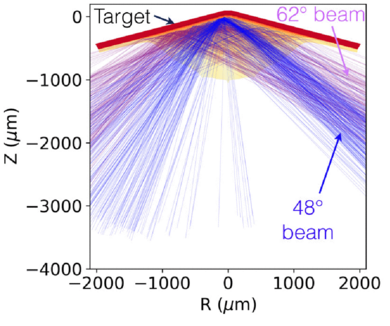Their results, recently published in Physical Review Letters, indicate that in the 'shock ignition' approach to direct drive laser fusion, laser plasma instabilities should not degrade the implosion. Robbie said, “This is an important result for laser fusion research as shock ignition is one of the most promising approaches to generating energy from laser fusion".
Laser Fusion
Laser fusion works by taking a small (about 2 mm) hollow sphere of frozen hydrogen (deuterium and tritium isotopes) and illuminating the outside of it with extremely high-power lasers, exactly in unison. The energy from the laser light is enough to compress the sphere, or 'implosion shell', inwards, creating an implosion which kick-starts fusion reactions.
The ultimate goal is to create so many fusion reactions that more energy is released than was used to start them, known as 'energy gain'. Theoretically, this could offer a near-infinite, carbon-free energy source, powered by deuterium and lithium obtained from seawater; though there are significant practical problems still to be overcome.
Direct vs. Indirect
Two different approaches to making laser driven fusion work are direct drive and indirect drive.
In indirect drive, the laser light is converted to x-rays using a device called a hohlraum (a hollow gold 'can') before it reaches the implosion shell. Last month, the US National Ignition Facility (NIF) reported a result using indirect drive which produced more fusion energy than the shell absorbed; about five times more. This was a crucial result as scientists now know for certain that the physics of laser fusion energy gain works. However, NIF did not achieve overall energy gain (fusion energy out/laser energy in), in part because only some of the x-rays created in the hohlraum illuminate the shell, reducing the energy going into the implosion.
Direct drive – shining the laser light directly onto the shell – does not need a hohlraum and so doesn't lose efficiency in the same way, meaning it should be able to get more energy onto the implosion and achieve higher energy gain. Direct drive, though, is also not without difficulties which make energy gain hard to achieve.
Laser Plasma Instabilities
One of the challenges faced by direct drive laser driven fusion is caused by instabilities in how the lasers interact with the target material. These laser-plasma instabilities reduce the efficiency of the implosion process, potentially requiring more energetic lasers to overcome them and achieve ignition.
Unfortunately, studying these instabilities on a laser with enough energy to achieve ignition isn't that practical. The National Ignition Facility (NIF) can fire 3 times a day, costs in the order of $1 million a time, and access is highly restricted, making it somewhat impractical as an experimental platform.
New Methodology
To overcome this, Robbie and his team designed and tested a novel, cone-shaped target – manufactured by Scitech Precision – on the University of Rochester's Omega laser (less energetic than NIF, but still 30 kJ).
A diagram of the novel target developed by the research team.

Taken from the paper published in Physical Review Letters, a diagram of the cone-shaped target the team developed, showing two of the laser beams and their geometry on the target.
By precisely controlling the angles of the incident lasers, and where on the target they illuminate, they created a new experimental platform which recreates the plasma conditions expected in NIF-scale direct drive experiments. The work provides a methodology for further study of laser plasma instabilities on smaller, more accessible lasers than NIF.
Shock Ignition
Shock ignition is an approach to direct drive laser fusion where a rapid rise in laser intensity towards the end of the implosion launches a strong shock into the implosion shell. This shock then initiates the fusion ignition process. Research indicates that using shock ignition, it may be possible to achieve the level of fusion energy gain required for power production using a laser smaller than NIF. However, due to the high intensity required for shock ignition, laser plasma instabilities are a concern, as these are typically worse at higher intensities.
Robbie and his team have, for the first time, evaluated the impact of laser-plasma instabilities in the plasma conditions which would be encountered in an 'ignition-scale' shock ignition implosion. Their work indicates that laser-plasma instabilities should not cause excessive degradation of the shock ignition implosion. This is encouraging for the continued pursuit of shock ignition as a future clean energy source.
Read the full paper at: Phys. Rev. Lett. 127, 065001 (2021) - Shock Ignition Laser-Plasma Interactions in Ignition-Scale Plasmas (aps.org).
----
The organisations involved in the research were: the CLF; Plasma Institute, University of York; Laboratory for Laser Energetics, University of Rochester; Los Alamos National Laboratory; University of Warwick; AWE Aldermaston; Dipartimento SBAI, Università di Roma “La Sapienza"; CELIA, University of Bordeaux; and MIT.
Top photo: An image of the cone shaped target (top right) developed by the research team.
